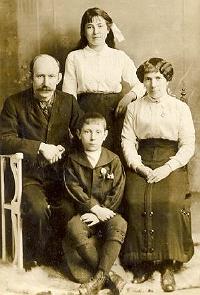|
The Belgian
refugees The occupation of Belgium by Germany during the First World War of 1914-18 resulted in a flood of refugees from their homeland into this country. There was great public sympathy
for them among the British people and every town and city was asked to help find them somewhere to live. Fund raising was also arranged and the headmistress of the Council School (Girls) in Bourne, Miss Clara Ward, collected 100 second hand garments that had been brought in by her pupils and after being repaired where necessary by the older girls, they were parceled up and sent to the Central Committee in London for distribution among the refugees. The first family sent to Bourne arrived in October 1914 and were housed at a cottage on a farm in Bourne North Fen. It consisted of a woman and her seven children, the youngest only seven months old, accompanied by her father. They said that their home in Belgium had been burned by the advancing Germans. The family stayed only a few weeks before returning to London and were housed elsewhere by the Central Committee.
During their stay, they had been looked after by the Congregational Church and they left on their own initiative in May 1917 hoping to meet with fellow Belgians and secure work in the capital. After the war, they returned to Belgium but one of them, daughter Marie, came back to Bourne. She had struck up a romantic attachment with a local lad, Harold Luesby, who was serving with the Royal Navy and they had met while he was home on leave. Marie lodged at first with Russell Hamling, a seedsman and greengrocer, and his family at their home in North Street, until the couple were married at the Abbey Church. Harold was then working as a builder and decorator and they went to live in Woodview and then in 1928 moved to a new home in Recreation Road. They had three children, a son, Graham, and two daughters, Jean and Pat. But Harold died of blood poisoning at the early age of 36 and Marie subsequently re-married to Dennis Martin but she too died in 1953 from cancer at the age of 52. All three children from the first marriage are still alive, Graham Luesby, now aged 74, a former painter and decorator, who lives in retirement in Gladstone Street, Bourne, and his sisters, Mrs Jean Parrish and Mrs Pat Broxholme. Graham remembers his Belgian relatives with affection because he spent many happy holidays with them before foreign travel had become so popular, staying for two weeks every year at Malines and elsewhere. A link with the Belgian refugees therefore remains alive in Bourne. A similar situation occurred in Britain when Belgium was invaded by Germany during the Second World War of 1939-45, creating a flood of refugees seeking asylum and by 1941 there were 23,000 Belgian civilians living in this country, constituting the largest allied colony in the United Kingdom, although none came to Bourne. Most of them had reached England in May-June 1940 and the majority found employment as a result of assistance from the Ministry of Labour. REVISED SEPTEMBER 2007 See also Bourne Military Hospital Charlie and Pat Broxholme
Go to: Main Index Villages Index
|
